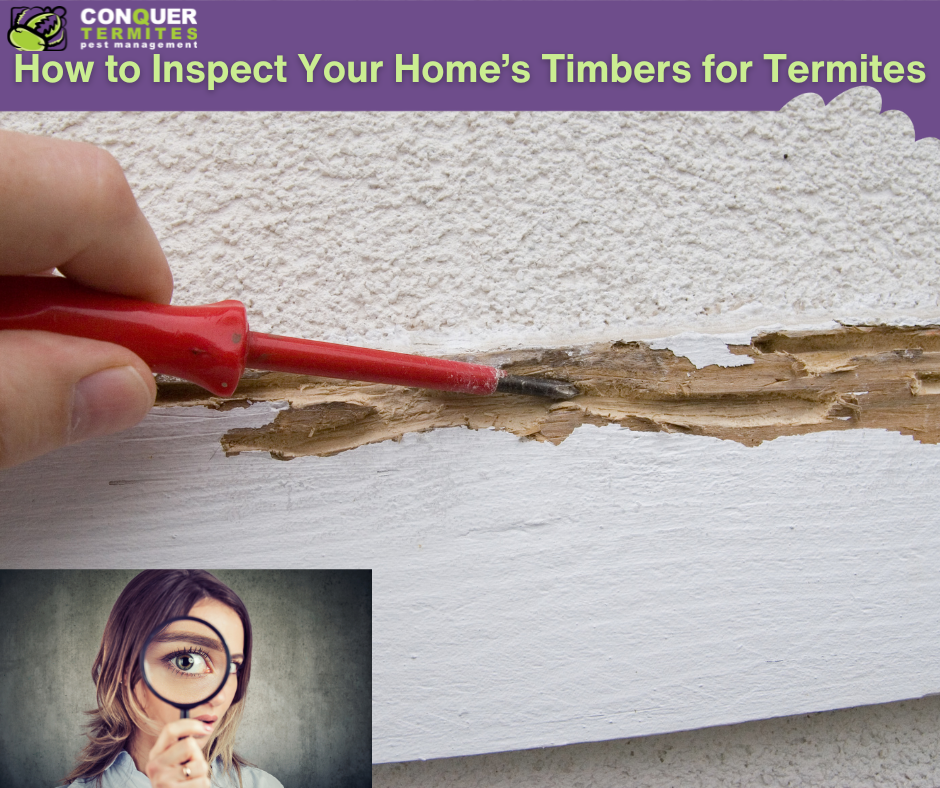How to Inspect Exposed Timbers in Your Home for Termites
In Brisbane, termites are a common and costly problem for homeowners. Checking your home’s exposed timbers regularly can help you spot signs of termite activity early, potentially saving you from significant repairs. This article will guide you through inspecting areas like door frames, window frames, and other exposed timbers that termites often target.
- Door Frames and Window Frames
Door and window frames are typically made of timber and are often vulnerable to termites, especially in areas exposed to the elements. To inspect these areas:
Look for peeling or bubbling paint, which can indicate termite activity beneath the surface.
Gently tap the timber frames with a screwdriver handle and listen for a hollow sound, which may suggest internal damage.
Check for any tiny mud tubes along the edges where timber meets the wall, as termites use these tubes to travel undetected.
- Skirting Boards
Skirting boards, which line the walls at floor level, are another common target for termites. To check skirting boards:
Run your hand along the boards to feel for any unusual bumps or warping.
Listen for a hollow sound when tapped, as this could indicate that termites have hollowed out the timber from within.
Look for cracks or slight separation from the wall, which might suggest internal damage.
- Timber Flooring
Timber floors can be damaged from below, where termites can chew through unseen. Here’s how to inspect them:
Walk over the flooring and note any areas that feel unusually soft, springy, or sagging, as this can be a sign of termite activity.
Check for any discolouration, warping, or uneven patches on the surface.
- Built-In Shelves and Cabinets
Especially if these are built against walls, shelves, and cabinets with timber elements can provide easy access for termites. Here’s what to look for:
Inspect the base of shelves and cabinets for any mud tubes, which termites use to move from one area to another.
Look for warping, especially on sections that are directly in contact with the wall, as this can indicate termite damage.
- Staircase Components
Timber staircases are not only practical but can also be vulnerable to termite damage. To check staircases:
Inspect the risers, handrails, and stringers for signs of mud tubes or any soft spots.
Lightly press on the staircase components, especially at the edges, to feel for any give or hollowness that could indicate internal damage.
- Exposed Beams and Support Posts
Exposed beams and support posts, common in both decorative and structural parts of the home, are often targeted by termites. When inspecting these areas:
Use a flashlight to examine beams for mud trails or signs of damage along the timber surface.
Check for any bowing, sagging, or weakening in the support posts, which could suggest termites have compromised the timber from within.
Regularly inspecting the exposed timbers in your home can help you catch termite activity early, protecting your investment and your home’s structure. By checking door frames, window frames, skirting boards, and other timber elements, you can spot warning signs before termites cause extensive damage. If you notice any of these signs, avoid disturbing the area and contact Conquer Termites for a professional inspection and tailored treatment options.
Call Us Now! on 1300 417 007
For more information on how to check for termites:
https://www.conquertermites.com.au/articles/2024-10-31-how-to-check-your-garden-for-termites/
https://www.conquertermites.com.au/articles/2024-11-07-how-to-check-for-termites-in-your-home/




